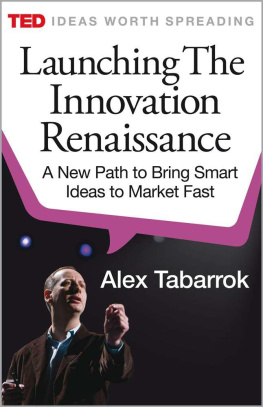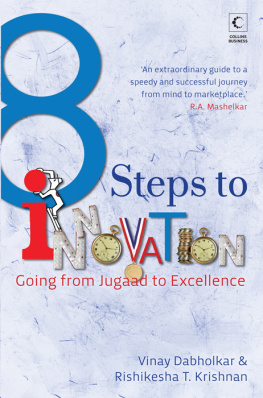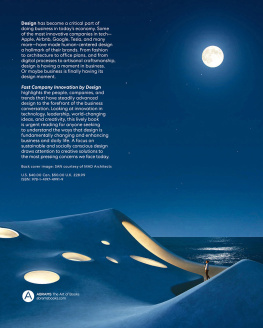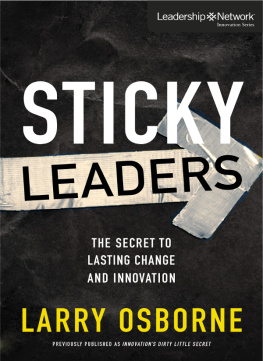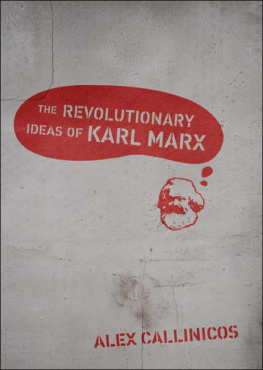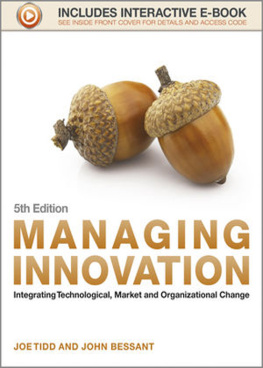Alex Tabarrok - Launching The Innovation Renaissance: A New Path to Bring Smart Ideas to Market Fast (TED Books)
Here you can read online Alex Tabarrok - Launching The Innovation Renaissance: A New Path to Bring Smart Ideas to Market Fast (TED Books) full text of the book (entire story) in english for free. Download pdf and epub, get meaning, cover and reviews about this ebook. year: 2011, publisher: TED Books, genre: Politics. Description of the work, (preface) as well as reviews are available. Best literature library LitArk.com created for fans of good reading and offers a wide selection of genres:
Romance novel
Science fiction
Adventure
Detective
Science
History
Home and family
Prose
Art
Politics
Computer
Non-fiction
Religion
Business
Children
Humor
Choose a favorite category and find really read worthwhile books. Enjoy immersion in the world of imagination, feel the emotions of the characters or learn something new for yourself, make an fascinating discovery.
- Book:Launching The Innovation Renaissance: A New Path to Bring Smart Ideas to Market Fast (TED Books)
- Author:
- Publisher:TED Books
- Genre:
- Year:2011
- Rating:5 / 5
- Favourites:Add to favourites
- Your mark:
- 100
- 1
- 2
- 3
- 4
- 5
Launching The Innovation Renaissance: A New Path to Bring Smart Ideas to Market Fast (TED Books): summary, description and annotation
We offer to read an annotation, description, summary or preface (depends on what the author of the book "Launching The Innovation Renaissance: A New Path to Bring Smart Ideas to Market Fast (TED Books)" wrote himself). If you haven't found the necessary information about the book — write in the comments, we will try to find it.
Alex Tabarrok: author's other books
Who wrote Launching The Innovation Renaissance: A New Path to Bring Smart Ideas to Market Fast (TED Books)? Find out the surname, the name of the author of the book and a list of all author's works by series.
Launching The Innovation Renaissance: A New Path to Bring Smart Ideas to Market Fast (TED Books) — read online for free the complete book (whole text) full work
Below is the text of the book, divided by pages. System saving the place of the last page read, allows you to conveniently read the book "Launching The Innovation Renaissance: A New Path to Bring Smart Ideas to Market Fast (TED Books)" online for free, without having to search again every time where you left off. Put a bookmark, and you can go to the page where you finished reading at any time.
Font size:
Interval:
Bookmark:
Launching The Innovation Renaissance
A New Path to Bring Smart Ideas to Market Fast
By Alexander Tabarrok
The Cathedral of Santa Maria del Fiore began to rise in 1296. From father to son, to son again, the architects, stonemasons and artists of Florence labored with love and devotion to produce the greatest cathedral the world had ever known. Pausing only for the black plague of 1348, the great cathedral grew until by 1418 all was complete but the dome. In a fit of mad ambition and optimism the basic design set over 100 years earlier called for a dome higher and wider than any that had ever been built either in 1296 or, as it turned out, in 1418. Without a dome, 122 years of work threatened to be uncrowned.
Unsure of how to proceed, the Arte della Lana, the guild of wool merchants who sponsored the cathedral, announced a prize: 200 florins and the commission would go to the best proposal to build the dome. Many entries were received, but the guild settled on the plan of Filippo Brunelleschi. The brilliant Brunelleschi had to invent new tools and techniques, but he proved up to the task and the dome was completed in 1436. For nearly 450 years it remained the largest in the world.
Among the tools Brunelleschi invented to complete his dome was a new type of paddleboat designed to carry marble down the river Arno. It was for this boat that Brunelleschi was granted what was arguably the world's first patent, a three-year monopoly. Brunelleschi's boat, nicknamed "the monster," sank on its maiden voyage but the idea of patents did not, and in 1474 nearby Venice passed the world's first general patent law.
Prizes and patents added the fuel of interest to the fire of genius, to use Abraham Lincolns wonderful phrase. As a result, literacy rates were high as was commercial numeracy. Continuing education was provided by The University of Florence and the University of Bologna (the worlds oldest).
The Florentines were obsessed with innovation because they lived by their wits. Florence had few natural resources. The wool merchants, for example, imported wool from England and alum and dyes from Turkey, India and the Middle East. Combining this raw material with sophisticated technology, they produced rich textiles that they exported around the world. Textile production was the high-tech sector of its day, and the Florentines needed innovative machines, methods and recipes to maintain their edge in production.
Competition in world markets meant that the Florentines had to innovate to prosper, but world markets also gave them the means to prosper. The opportunity to sell large quantities meant that incentives to research and develop new tools and techniques were strong and funds for innovation were readily available.
Trade also benefited the Florentines by bringing them into contact with the world's best ideas. Islamic artistry in silk, ceramics and metal inspired the Florentines, as did unmatched Chinese porcelain. The cosmopolitan Florentines were also among the first Europeans to adopt Arabic numerals. This increased the speed and flexibility with which they could balance their accounts and gave them an edge in banking as well as in trade.
Thus, in Florence, the epicenter of the Renaissance, we see five factors propelling that city's innovation: patents, prizes, education, global markets, and cosmopolitanism, an openness to ideas from around the world. How do these factors apply today? What combination of incentives and foundation will bring the greatest innovation to the modern world? How can we create a 21st-century Renaissance?
These questions are especially important now because the early 21st century has not been kind to the United States. The new century dawned with the destruction of the World Trade Center, and its first decade closed with the worst recession since the Great Depression. We face continuing wars, significant debt and divisive politics. Not all of our problems are recent in origin or likely to be resolved quickly. Most significantly, productivity growth, our best measure of innovation, fell dramatically in the United States in the post-1973 era and has not yet picked up again.
The United States needs to innovate to thrive; thus a reexamination of the motivations, foundations and achievements of our innovation policy is in order.
In empowering Congress to create patents, the U.S. Constitution offered a standard justification, "to promote the Progress of Science and useful Arts." One negative aspect of patents is well-known: Patents increase monopoly power and raise prices. Patented pharmaceuticals, for example, are much more expensive than unpatented generics. But there is also a more fundamental critique: After hundreds of years of experience, there is surprisingly little evidence that patents actually do promote the progress of science and the useful arts.
The theory behind patents seems sound. Imitation is cheaper than innovation, so the worry is that firms that invest in innovation won't have time to recoup their innovation costs if other firms are allowed to immediately imitate. The theory dates back at least to 1834, when Jeremy Bentham wrote that "the protection against imitators" is necessary because "he who has no hope that he shall reap will not take the trouble to sow." The "recouping the costs of innovation" theory is the traditional theory of patents among economists, although, as we shall see, it is not much reflected in patent law.
The trouble comes when we try to correlate the existence or strength of patent law with measures of innovation. In the 19th century, for example, some countries, notably Switzerland, Denmark and later the Netherlands, had no patents at all and other countries had weak patent rights. According to the traditional theory, countries without patents should innovate very little. Yet that was not the case countries without patents had as many innovations as those with patents, and in international fairs such as the Crystal Palace Exhibition in London in 1851 they even received a disproportionate share of the medals for outstanding innovations.
For more than 70 years, All-American Rose Selections has named a best rose of the year. The 2009 winner, produced by the research team at Meilland International, was Carefree Spirit, a rose said to have "deep red blossoms with white twinkles in their eyes." "Carefree Spirit" is the name, but be warned: Use cuttings to grow more of these roses in your backyard and you will be breaking the law. Carefree Spirit is patented (PP #20,175).
It's surprising that roses are patented because over the centuries tens of thousands of new rose varieties have been created. As early as 2,500 years ago the Chinese were breeding new roses, and Confucius tells us that the emperor had hundreds of books about roses and rose breeding in his library. The world did not appear to lack new roses even though, until 1930, no roses were ever patented. Nevertheless, in 1930 the Plant Patent Act (PPA) gave rose breeders in the United States the right to exclude competitors. Have patents increased rose innovation?
Roses are a good test for the power of patents because, whether they are patented or not, roses are registered so we have good data on rose innovation as well as on rose patents.
It's not even clear whether patent rights increase the total number of new roses: Many of the roses that were patented (16 percent of the total) would probably have been created even without the right to exclude competitors, just as were the majority of new roses. Indeed, after the PPA of 1930 was passed, U.S. rose registrations declined relative to those in Europe, which had less patent protection than the U.S.
Font size:
Interval:
Bookmark:
Similar books «Launching The Innovation Renaissance: A New Path to Bring Smart Ideas to Market Fast (TED Books)»
Look at similar books to Launching The Innovation Renaissance: A New Path to Bring Smart Ideas to Market Fast (TED Books). We have selected literature similar in name and meaning in the hope of providing readers with more options to find new, interesting, not yet read works.
Discussion, reviews of the book Launching The Innovation Renaissance: A New Path to Bring Smart Ideas to Market Fast (TED Books) and just readers' own opinions. Leave your comments, write what you think about the work, its meaning or the main characters. Specify what exactly you liked and what you didn't like, and why you think so.

